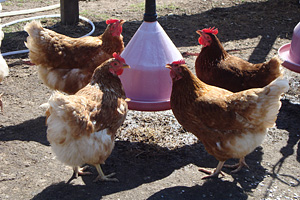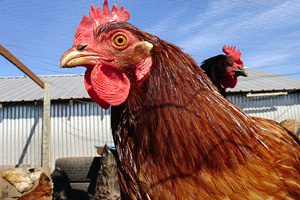Humane Culling
Published on 2 February 2013 in Food, health and wellbeing
SRUC’s research programme developed a technique which can be used by the UK Government and others to humanely cull large numbers of commercial poultry in the event of a disease outbreak (such as Avian Flu). This method not only provides better protection for the animals involved but also should also prove far more cost-effective for the livestock industry. Previously similar techniques for culling poultry were found to be unreliable, compromising bird welfare and risking disease spreading further which can be extremely costly to those countries affected.

Key Challenges
Previous attempts to control Avian Flu – also known as HPAI – outbreaks (eg in the Netherlands in 2003) using gas and other techniques to cull poultry on-farm led to welfare concerns. The birds’ welfare could be severely compromised by the culling procedure itself and by ineffective culling. Live birds were sometimes found among the dead days after the culling had taken place. If it is ineffective culling birds on a large scale can also be very expensive; the Netherlands outbreak cost the country an estimated €770m. It was clear a method of culling large numbers of birds that was both humane and cost-effective needed to be designed.
Key Benefits
After researching various gas types and mixtures to identify those that caused the birds the least ill effect before they lost consciousness, SRUC designed a novel portable injection lance. This method allowed a road tanker of liquid gas to be injected into the poultry house via a 32mm bore pipe. The design allows gas to be introduced safely into even poor quality buildings, while the minimum preparation required protects the workforce and, by minimising the logistics associated with using the equipment, the risk of inadvertent transmission of the disease is significantly reduced.
Ultimately the process was validated through a number of tests conducted by the UK Government to confirm the suitability of the equipment for use across a wide range of housing types.
As evidenced by the Dutch experience, failure to contain an outbreak of HPAI is ruinously expensive, destroys commercial and breeding flocks that can take years to replace as well as damaging public confidence in a product.
The procedure has been adopted by a number of countries including Great Britain and Northern Ireland and so is now available as a means of culling large commercial poultry flocks in the UK in the event of an Avian Flu outbreak or similar. Members of the project team also provided input into standard operating procedures that would be used by the state veterinary service and any contractors or farm staff.
As evidenced by the Dutch experience, failure to contain an outbreak of HPAI is ruinously expensive, destroys commercial and breeding flocks that can take years to replace as well as damaging public confidence in a product. Irrespective of the number of animals to be killed it must be done in a way that minimises the impact on both animal and human welfare. The protocol developed under this project provides both Government and industry with a means of achieving these sometimes apparently conflicting needs.


Comments or Questions
Related Websites
Our Partners
University of Glasgow, University of Bristol, Yara, Bix Solutions
Find Out More
Visit Professor Nick Sparks SRUC Research Profile, https://www.sruc.ac.uk/nsparksAuthor
Professor Nick Sparks Nick.Sparks@sruc.ac.uk







